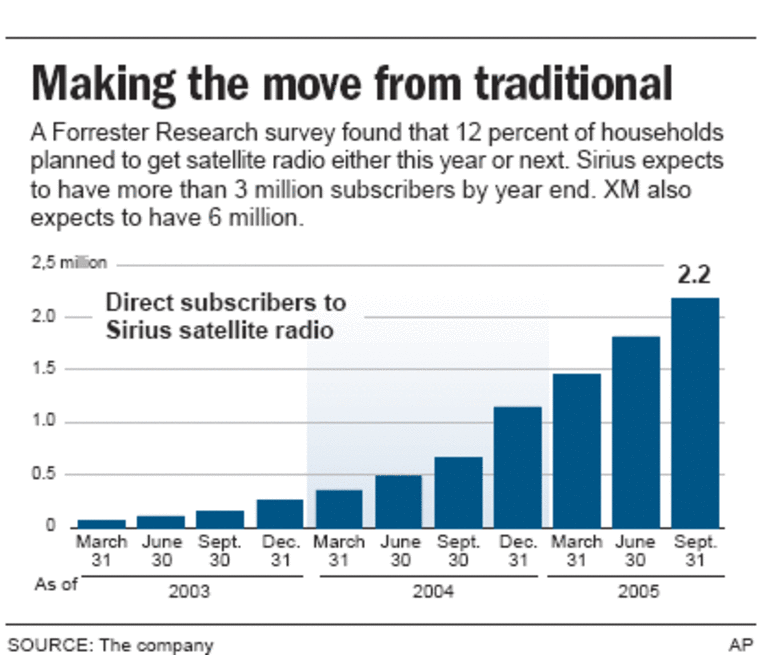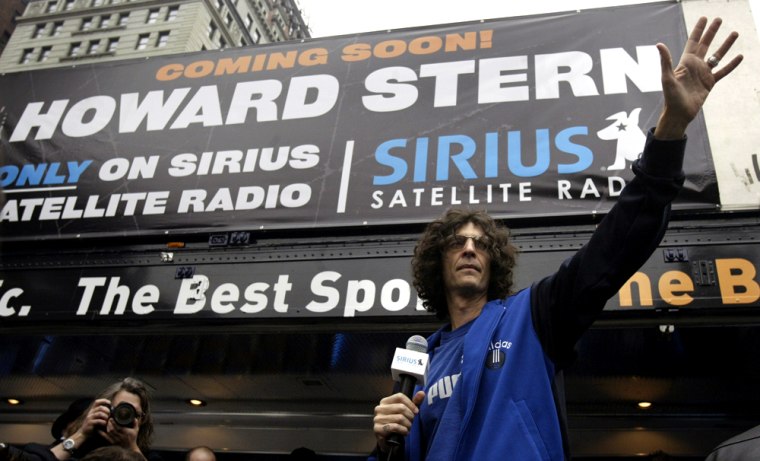For Dan McLain of Chagrin Falls, Ohio, there was a compelling reason to buy a satellite radio receiver: shock jock Howard Stern's looming move off the traditional airwaves. "It's just a show I enjoy. I'm a listener, and my wife's a listener," he said.
On Jan. 9, Sirius Satellite Radio is set to boast the arrival of its biggest on-air personality yet in Stern. While consumers may be tempted to sign up for Sirius or larger rival XM based on ever-expanding programming lineups, falling radio prices may be an even more compelling lure for consumers. Some radios are selling for half the price they commanded last holiday season.
For the companies themselves, the race is on to achieve profitability as they invest hundreds of millions of dollars in new programming. For the third quarter, both XM and Sirius reported net losses of more than $100 million. Profitability is expected a few years from now as more subscribers sign up.
A recent check of prices found some satellite radios selling at $50 or less including rebates. Industry insiders say that reflects the benefit of falling prices of components used to make the radios. It also reflects fierce competition in the two-player market.
For both companies, getting radios into the hands of consumers is the necessary first step toward getting monthly subscriber fees, their key source of revenues. Both XM and Sirius charge $12.95 a month.
"This is a razors and blades business," said Craig Moffett, an analyst with Sanford C. Bernstein. "Discounting of radios is one of the obvious levers they've got to stimulate subscription demand, because over the long term, that's where they make their money."
This holiday shopping season is viewed as key for the satellite radio services. XM has said it expects to have 6 million subscribers by the end of this year. Sirius says it expects to have more than 3 million.

"In our industry as with other consumer electronics companies, 40 percent of your growth can come in the fourth quarter, which has been our history over the last few years," said Hugh Panero, CEO of Washington-based XM Satellite Radio Holdings Inc.
Mel Karmazin, CEO of Sirius Satellite Radio Inc., based in New York, said it is important to have products at the high and low ends of the price range. Sirius is the first to have a radio that can also play MP3 files, its S50 portable. XM is due to follow with MP3 models early next year.
"The fact is that the broader the price range, the more appealing it is to different segments of the population," Karmazin said.
At Crutchfield Corp. in Charlottesville, Va., a catalog and Internet consumer electronics retailer, the S50 is "red hot," said Rick Souder, executive vice president of merchandising. Sets are selling about as quickly as they come in, he said.
The S50 is the unit purchased by McLain, who was concerned about no longer being able to listen to Stern while driving around the Cleveland area. He also bought a less expensive model for his wife to use.
The hot seller last holiday season was XM's portable MyFi XM2Go, then priced at $329, Souder said. This year, the same model is selling at Crutchfield for about half that, and Souder said most satellite radio prices are down 30 to 50 percent from last year.
Karmazin says anticipation of Stern's arrival is a selling point for Sirius.
"We believe that as Howard is counting down the number of days that he has left on what he calls old-fashioned radio, that people are interested," he said. "We think it will be a big item for Howard fans for the holiday season this year."
Both Sirius and XM are working hard to market their unique programming. While XM has Major League Baseball and the shock jock duo Opie and Anthony, Sirius has the NFL, Stern and a recently unveiled partnership with Martha Stewart.
Panero suggested Sirius is taking a narrowly focused low road, branding it as "raunchy," but Karmazin said satellite radio is all about giving listeners a choice.
"I believe that America deserves a choice in the content that it wants to receive," he said, noting that Sirius also has channels aimed at children.
Karmazin bristled at Panero's characterization, saying Stern "is the single biggest personality over the last 20 years in radio. And if the geniuses at XM want to categorize that as 'raunchy,' that's their word."
The parallel fortunes of Karmazin and Stern mark a transition point for both the traditional and satellite broadcasting realms. Karmazin moved to Sirius after serving as president of media giant Viacom Inc. He was Stern's old boss at Viacom's Infinity Broadcasting, and his move to Sirius last year came just weeks after Sirius announced a $500 million pact with Stern.
Analysts believe that Stern's migration from traditional, or terrestrial, radio may actually help both satellite radio companies.
Stern's planned move has put satellite radio on the map, said Jason Helfstein, senior media analyst with CIBC World Markets. It will be a test to see how many of Stern's listeners will be willing to move to satellite, he said.
Bernstein's Moffett estimated that out of Stern's 12 million current listeners there are 4 million hard-core "zealots," many likely to pay the subscription fee.
Moffett said the Stern move "legitimizes" satellite radio by giving it "a big name and giving it a face." He looks for sales to get a boost through the first quarter of 2006.
Ted Schadler, an analyst with Forrester Research in Cambridge, Mass., said a survey found that 12 percent of households planned to get satellite radio either this year or next. That number is likely to grow as Stern's move draws more attention, he said.
Sirius and XM are also relying on demand from new car buyers through their separate, exclusive pacts with auto manufacturers. In both cases, the service is offered free for an introductory period. After the trial, the consumer must decide whether to continue listening and pay for the service.
Long-term growth forecasts vary. Moffett looks for 44 million satellite radio subscribers by 2010. Forrester's Schadler looks for more than 20 million households, a different measure, over the same period. In either case, it means that Stern will have to settle for a smaller initial audience, expecting continued growth, as he begins his new career on satellite radio.
